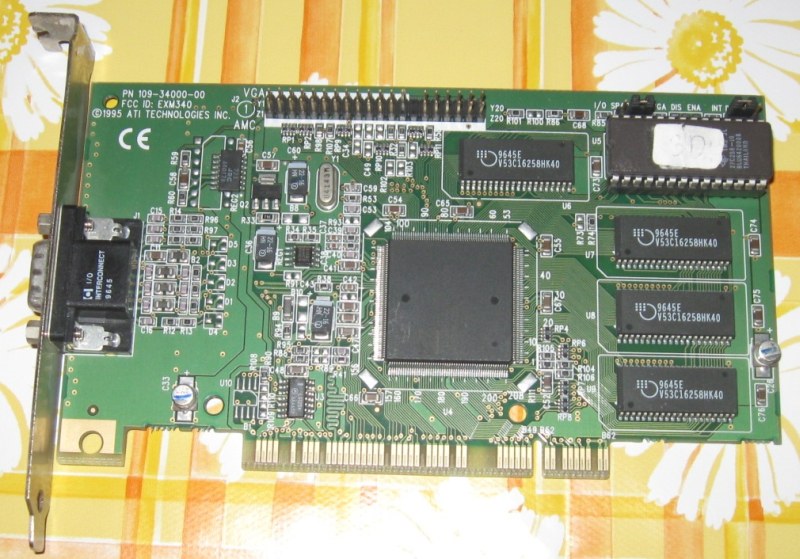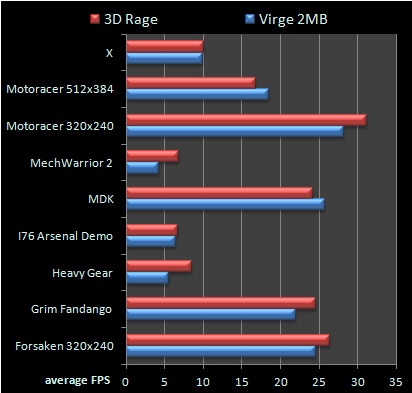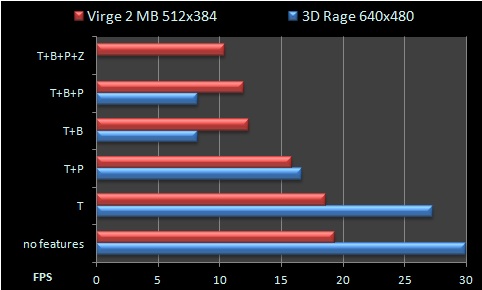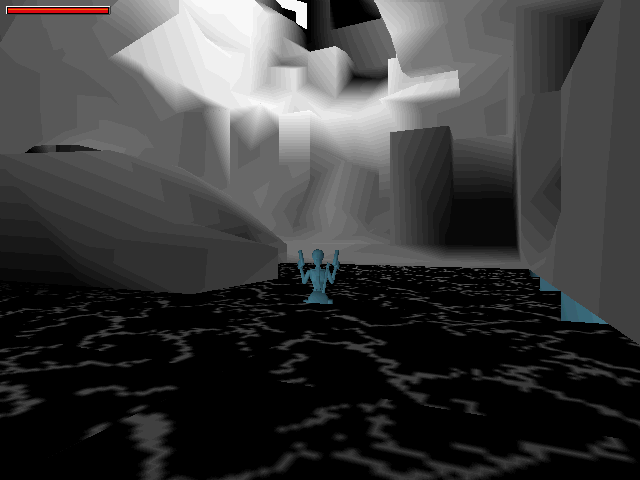ATI enters the fray
Just like Matrox ATI was a Canadian graphics company with long history before 3D. Array Technologies Inc. was founded in 1985 and started with production of integrated graphics for big computer makers. In 1987 ATI entered retail with EGA and VGA Wonder cards. In 1991 came first hardware accelerated chip mach8 and one year later the first GUI accelerator mach32. In 1995 ATI was a big graphics company with strong presence of various 2d accelerators build on mach64 architecture. The mach64CT with integrated DAC and clock synthesizer was a fundament for a line of 3D accelerators. The first was called 3D Rage, announced in November 1995 and some people consider it a release date as well. But to my knowledge the mach64GT chip did not appear on the market until spring 1996.
3D Xpression
 And here is the concrete incarnation. Pretty simple board since 3D Rage is completely integrated solution. 3D Xpression carries two megabytes of 40 ns EDO memory. It should be clocked at 57 MHz. The sticker was already there when I bought it. Wonder if it helped somebody believe this is really a 3d accelerator.
There is a nice headroom in my card. Clocks can be raised by 30% until memory becomes unreliable. And without surprises there was 30% average gain exactly copying clock increase. I don't want to have another graph just for that.
And here is the concrete incarnation. Pretty simple board since 3D Rage is completely integrated solution. 3D Xpression carries two megabytes of 40 ns EDO memory. It should be clocked at 57 MHz. The sticker was already there when I bought it. Wonder if it helped somebody believe this is really a 3d accelerator.
There is a nice headroom in my card. Clocks can be raised by 30% until memory becomes unreliable. And without surprises there was 30% average gain exactly copying clock increase. I don't want to have another graph just for that.
Mach64 GT and?
The GT family contains all the 3D Rage and Rage II cores, but alongside GT was also a VT line. Why do I bother writing about VT? The VT line never carried the 3D moniker yet it also featured similar functionality as it evolved alongside 3D Rage to Rage IIc path. Next to first Rage was a Video Xpression board based on VT2 chip. It is actually often reported as a member of GT family. And so I had to test it and got confused with two games which could seem to at least partially accelerated: Forsaken and X.

Such images from Forsaken could make one think this is a midstep in the 2d to 3d transition (as timeline would suggest), but the game is just so adaptive even hardware accelerated executable does not give any warnings. To be sure I also tried 3D Rage bios in the VT2 but did not discover any secrets inside. It was only evolution of the CT chip with added orthogonal hardware video overlay and scaler. But later member of the VT line is going to be tested since it really is all around 3D accelerator.
Real Rage Architecture
On ATI's papers the Rage looks like it should leave competition in smoke. It was supposed to be full featured Direct3d accelerator, but as Microsoft was delaying the release more features were added to the API and Rage turned out largely incompatible with many games. What can it do? All the mach64VT can do, plus improved video filtering, bus mastering and the 3d acceleration. Besides basic Gouraud and flat shading 3D Rage promised perspectively correct texture mapping, bilinear texture filtering, sub-pixel accuracy, depth buffering with sorting for rejection of hidden pixels, source and destination alpha blending. Sounds good enough to drive at least early DirectX games, but there was also support for BRender, RenderWare and Apple's QuickDraw 3D. For what I know little has come out from support for all major APIs. Given a chip clock of 44 MHz on my card, 3D Rage has peak fillrate of 22 million perspectively correct texture mapped pixels per second and perhaps can somehow achieve claimed 600K Gouraud shaded triangles per second geometry performance. Memory clock is reported at 57 MHz. These were the best single chip performance figures available among gaming chips until PowerVR, Rendition and 3dfx dropped their bombs later that year. 4 MB of memory was supported, but all cards I know about were equipped with only 2 MB. I even heard about single megabyte card, which would just scratch any hope for reasonable 3d. Also, all the models used EDO memory, even if the chip should also support shiny new SGRAM. Only extra help for the CPU and faster texture swapping is PCI bus mastering. 3D Rage supposedly supports trilinear texture filter, but none of my games working with the card has this option available for tests. Chroma key comparison for texture transparency works. There is some sub-pixel accuracy and hardware color calibration as well. For 3d games it all sounds good, with real alpha blending, fog and texture lighting support. Looks like we have all the basics, or do we? ATi was not pushing proprietary CIF environment and fully embraced open APIs. Yet the true "rage" starts with Direct3D compatibility, because Z-buffering is actually missing!
Experience
 Turning on mip mapping in Flight Simulator at 640x480 is a bit too much.
Turning on mip mapping in Flight Simulator at 640x480 is a bit too much.Latest official 2139 drivers are used. Two megs of memory for 3d rendering, even without depth buffer, is still significantly limiting 3d modes. Maximum resolutions of 640x480x16 or 400x300x32. Yes, there is 32 bit 3d mode, but blending operations are causing color corruption in true color depth. 2D resolution with 135 MHz ramdac peaks at blurry 1280x1024. It supports 8-bit palettes for textures, helping to get away with small capacity. I tried also newer version of Rage II drivers (yes it works) and older built-in Windows 95 OSR2 driver but there was no improvement. You will notice from low number of benchmarks how many games fail with the chip. Despite video texturing support the Rage is not displaying them in Mortal Kombat. Bike shadows in Motoracer are simple rectangles. Due to small memory capacity maximum resolution without texture drops is 640x400 in Motoracer and 512x384 in Forsaken. Flight Simulator 98 can do 640x480 without mip maps. I could not get any OpenGL title to work even with my wrappers. The exception is of course special case of Su-27, and there the Rage also does not help the performance. Out of my whole bench suite the Rage could go through only seven titles, three of them using Mechwarrior 2 engine:

Since I wanted a comparison with Virge 2 MB I had to use maximum resolution of 512x384 for Motoracer. At that setting the hiccup bug did not happen and voila- this is the one game where S3 wins in both speed and quality.

And since framerate difference is not so big and only so few games are rendered properly I cannot help it: first Virge with 2 MB of memory was actually better 3d accelerator then first Rage. There I said it. More evidence can be seen in Rage screenshot gallery.
But I do not want such short articles, so I spent some time with Tomb Raider 2. Results from TR2 were not included to the benches above because the 3D Rage cannot display textures in the game. However, there is a speed difference between disabled textures from start and failure to display them. Perhaps it is later in the rendering when the game hits on 3D Rage incapabilities and outputs only Gouraud shaded scenes. Nevertheless, I run benches with various features hoping to find how taxing are these operations. In following picture T stands for texturing, P for perspective correction, B for bilinear texture filter and Z is for Z-buffering. For comparison there is again Virge 2 MB at resolution of 512x384, highest possible without dropping textures. You can click on the graph for minimal framerates.

Since also texture features are causing framerate drop I am pretty sure the 3D Rage is really doing all relevant computing, even if it is not visible in the end. It is noteworthy how significant is impact of perspective correction. Only even bigger hit from bilinear filtering (happens in other games also) can hide it. Low filtering performance is hinting at lack of texture caching. It does not look too bad because even speed of basic texturing is quite low. Even if trilinear was supported (and it was in ATI's announcement, but that blurp had to be about some hack around true trilinear filter), the speed should skydived due to many pending texture reads. While 3D Rage can do Gouraud shading at "full speed", it does not look like ATi properly estimated how critical texture mapping will be for gaming accelerator.
 One advantage of no texturing is such a clear look at low color precision of Gouraud shading on the 3D Rage, assuming dithering is disabled.
One advantage of no texturing is such a clear look at low color precision of Gouraud shading on the 3D Rage, assuming dithering is disabled.
Summary
What more to say. ATI went through same pain like Nvidia and 3Dlabs did in 1995. As a 3d accelerator first Rage proved quite useless. Like other chips from the first generation of texture mappers, it was a reputation destroyer rather than builder. Fortunately for Ati, their marketing did not raise very high expectations to begin with. Limited feature set, especially failure to deliver DirectX compatible depth buffering, only meant that the 3D Rage was degraded into solid 2d card. However Ati was not to let the future 3d gaming crowd slip away and quickly delivered more capable Rage II chip.
Rage II family review